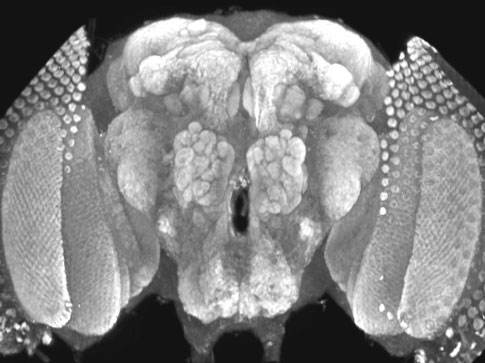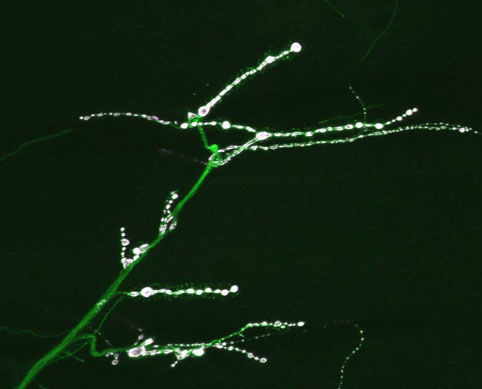|

| |
Muscular Dystrophy
 An
additional area of research in the lab is to identify and characterize molecular
mechanisms that underlie muscle damage and repair in a Drosophila
myopathy model. Recent molecular characterizations of myopathies and muscular
dystrophies have revealed a striking complexity of muscle diseases in humans.
Muscular dystrophies can arise from mutations affecting structural proteins,
sarcoglycan membrane proteins, nuclear membrane proteins, and enzymes, leading
to progressive weakness and degeneration of skeletal muscles. These disorders
may also functionally denervate the muscle by disruption of postsynaptic
receptor clustering at the synapse. Though much has been learned from the
molecular characterization of myopathies, it remains unclear how diseased fibers
alter neuromuscular function. In addition, whether disease-triggered
reorganization of the actin cytoskeletal network within muscle contributes to or
partially alleviates muscle dysfunction is unknown. The genetic tractability of
Drosophila has made it an ideal system to characterize mutations
affecting neuromuscular function. To further analyze the pathology associated
with muscular dystrophy, we have generated a hypercontraction-induced myopathy
model using dominant mutants in the Myosin heavy chain (Mhc) locus
in Drosophila. These mutants are caused by single amino acid changes
within the ATP binding/hydrolysis domain of Mhc and lead to degeneration of the
flight muscles. Electrophysiological analysis has revealed
temperature-dependent seizure activity in dystrophic adult muscles. In
addition, larval physiology demonstrates spontaneous muscle movements in the
absence of neuronal stimulation and extracellular Ca2+, indicating a
dysregulation of intracellular Ca2+ homeostasis in damaged muscles.
Utilizing genome-wide DNA microarray analysis, we have determined the
transcriptional response to muscle dysfunction in Drosophila, revealing a
conserved muscle remodeling pathway similar to mammalian myopathy models.
The altered gene expression includes upregulation of several classes of
actin binding proteins, suggesting cytoskeletal remodeling pathways in damaged
muscle may potentially counteract the effects of primary muscle dysfunction. We
are now characterizing the functional consequences of the transcriptional
response to myopathy and using the genetic tractability of Drosophila to
identify mechanisms underlying degeneration and repair of dystrophic muscles. An
additional area of research in the lab is to identify and characterize molecular
mechanisms that underlie muscle damage and repair in a Drosophila
myopathy model. Recent molecular characterizations of myopathies and muscular
dystrophies have revealed a striking complexity of muscle diseases in humans.
Muscular dystrophies can arise from mutations affecting structural proteins,
sarcoglycan membrane proteins, nuclear membrane proteins, and enzymes, leading
to progressive weakness and degeneration of skeletal muscles. These disorders
may also functionally denervate the muscle by disruption of postsynaptic
receptor clustering at the synapse. Though much has been learned from the
molecular characterization of myopathies, it remains unclear how diseased fibers
alter neuromuscular function. In addition, whether disease-triggered
reorganization of the actin cytoskeletal network within muscle contributes to or
partially alleviates muscle dysfunction is unknown. The genetic tractability of
Drosophila has made it an ideal system to characterize mutations
affecting neuromuscular function. To further analyze the pathology associated
with muscular dystrophy, we have generated a hypercontraction-induced myopathy
model using dominant mutants in the Myosin heavy chain (Mhc) locus
in Drosophila. These mutants are caused by single amino acid changes
within the ATP binding/hydrolysis domain of Mhc and lead to degeneration of the
flight muscles. Electrophysiological analysis has revealed
temperature-dependent seizure activity in dystrophic adult muscles. In
addition, larval physiology demonstrates spontaneous muscle movements in the
absence of neuronal stimulation and extracellular Ca2+, indicating a
dysregulation of intracellular Ca2+ homeostasis in damaged muscles.
Utilizing genome-wide DNA microarray analysis, we have determined the
transcriptional response to muscle dysfunction in Drosophila, revealing a
conserved muscle remodeling pathway similar to mammalian myopathy models.
The altered gene expression includes upregulation of several classes of
actin binding proteins, suggesting cytoskeletal remodeling pathways in damaged
muscle may potentially counteract the effects of primary muscle dysfunction. We
are now characterizing the functional consequences of the transcriptional
response to myopathy and using the genetic tractability of Drosophila to
identify mechanisms underlying degeneration and repair of dystrophic muscles.
|




